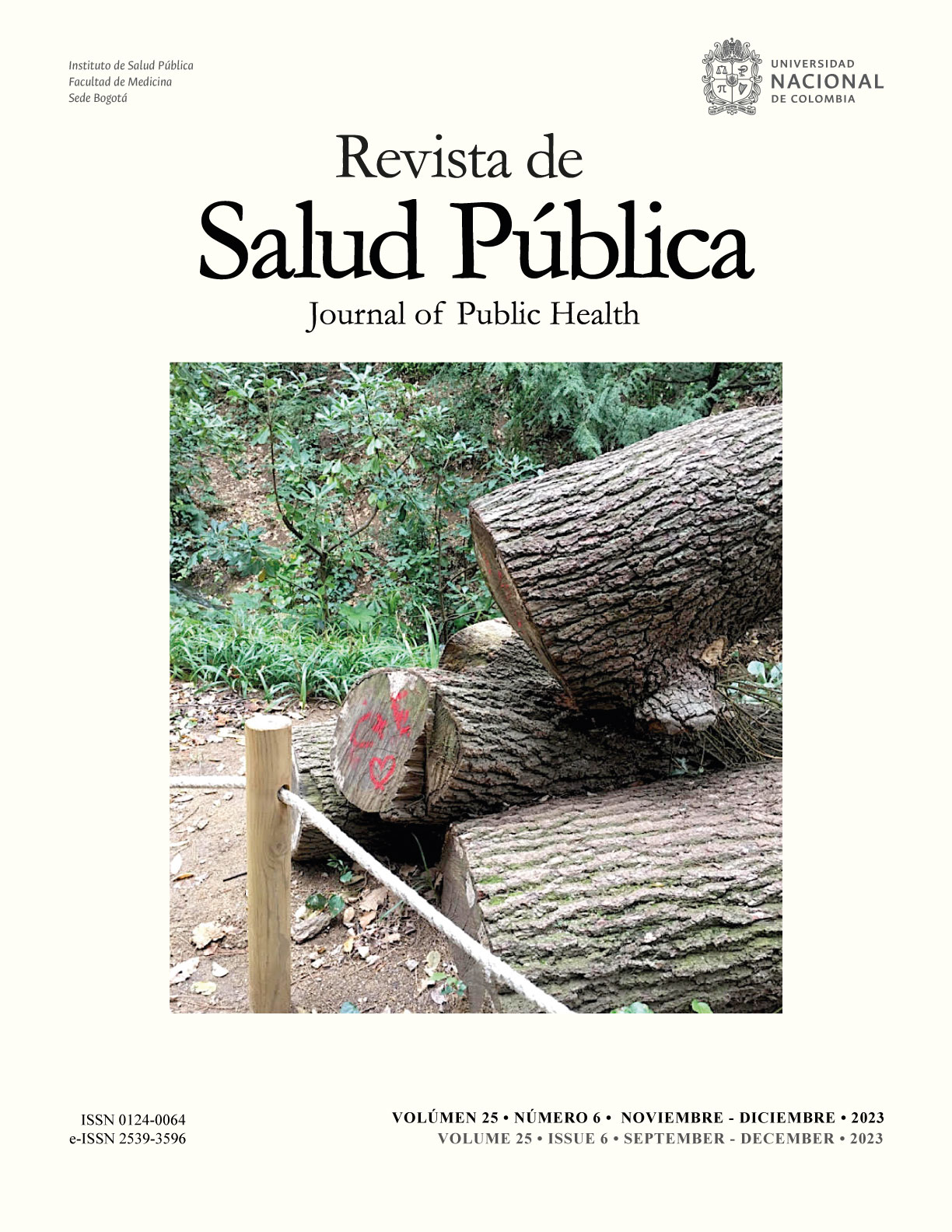Caracterización de conjuntivitis infecciosa en un centro de cuarto nivel de atención, Bogotá, Colombia
Characterization of infectious conjunctivitis in a fourth-level care center, Bogota, Colombia
DOI:
https://doi.org/10.15446/rsap.v25n6.110422Palabras clave:
Covid-19, infección respiratoria por SARS-CoV-2, cuarentena, higiene de manos, medidas de bioseguridad, aislamiento, conjuntivitis infecciosa (es)Covid-19, respiratory infection by SARS-CoV-2, quarantine, hand hygiene, biosecurity measures, isolation, infectious conjunctivitis (en)
Descargas
Objetivo El propósito de este estudio es describir las características clínicas y demográficas de la población que consultó al servicio de urgencias por conjuntivitis desde el 1.o de marzo del 2019 hasta el 1.o de marzo del 2021 y evaluar la frecuencia de presentación de patologías oculares infectocontagiosas, como es el caso de la conjuntivitis bacteriana.
Métodos Se realizó un estudio descriptivo transversal en una cohorte histórica en el Departamento de Cirugía, Unidad de Oftalmología del Hospital Universitario San Ignacio, Bogotá D.C. desde marzo de 2019 hasta el 1.o de marzo de 2021. El estudio incluyó pacientes con diagnóstico de conjuntivitis bacteriana y pacientes con diagnóstico de conjuntivitis viral sobreinfectada, y excluyó a todos los pacientes con resultado positivo para COVID-19 y a los pacientes con síntomas sugestivos de infección por SARS-CoV-2. De los pacientes, 629 cumplieron con los criterios de selección.
Resultados Entre marzo del 2019 y abril del 2020 se registraron 534 consultas al servicio de urgencias de la unidad de oftalmología, y a partir del día 24 de abril del 2020 (cuando entró en vigencia la Resolución 666 sobre medidas de bioseguridad) hasta marzo del 2021 se registraron 95 consultas. Gran parte de los pacientes presentaron conjuntivitis viral, seguida por conjuntivitis viral sobreinfectada, y en tercer lugar de conjuntivitis bacteriana.
Conclusión Se estimó que medidas de bioseguridad como el aislamiento, el lavado frecuente de manos o el uso de tapabocas pudieran explicar la notoria reducción de los casos de propagación de conjuntivitis infecciosa en la comunidad.
Objective The purpose of this study is to describe the characteristics of the populations that consulted to the emergency service due to conjunctivitis from March 1 of 2019 to March 1 of 2021 and evaluate the frequency of presentation of contagious ocular pathologies like is the case of bacterial conjunctivitis.
Methods A descriptive cross-sectional study was conducted in a historical cohort in the Department of Surgery, Ophthalmology Unit of the Hospital Universitario San Ignacio, Bogotá D.C. from March 2019 to March 1, 2021. The study included patients with a diagnosis of bacterial conjunctivitis and patients with a diagnosis of superinfected viral conjunctivitis, and excluded all patients with a positive result for COVID-19 and patients with symptoms suggestive of SARS-infection CoV-2. Of the patients, 629 met the selection criteria.
Results Between March 2019 and April 2020, 534 consultations were registered in the emergency department of the ophthalmology unit, and from April 24, 2020 (when resolution 666 on biosecurity measures started) until March 2021, 95 consultations were registered. The majority of the patients presented with viral conjunctivitis, followed by superinfected viral conjunctivitis, and bacterial conjunctivitis.
Conclusion We hypothesize that biosecurity measures such as isolation, frequent hand washing, and the use of face masks could explain the marked reduction in cases of infectious conjunctivitis in the community.
Referencias
Esteva Espinosa E. Conjuntivitis. Offarm [Internet]. 2004 [citado 2022 Jul 25]; 23(11):60-6. Disponible en: https://bit.ly/435p7H3.
Azari AA, Barney NP. Conjunctivitis: A systematic review of diagnosis and treatment. JAMA. 2013; 310(16):1721-30. https://doi.org/10.1001/jama.2013.280318.
Yeu E, Hauswirth S. A Review of the differential diagnosis of acute infectious conjunctivitis: implications for treatment and management. Clin Ophthalmol. 2020; 14:805-13. https://doi.org/10.2147/OPTH.S236571.
Rietveld RP, van Weert H, ter Riet G, Bindels P. Diagnostic impact of signs and symptoms in acute infectious conjunctivitis: systematic literature search. BMJ. 2003; 327:789. https://doi.org/10.1136/bmj.327.7418.789.
Eduardo N, Pinilla V, Martín-Gil I. Conjuntivitis en el niño. FMC- Form Med Contin Aten Primaria. 2008; 15(7):444-50. https://doi.org/10.1016/S1134-2072(08)72216-3.
Alfonso S, Fawley J, Lu X. Conjunctivitis. Clin Off Pract. 2015; 42(3):325-45. https://doi.org/10.1016/j.pop.2015.05.001.
Centro para el control y la prevención de enfermedades (US), Centro Nacional de Inmunización y Enfermedades Respiratorias (NCIRD), División de Enfermedades Virales. Conjuntivitis [Internet]. 2019 [Citado 2021 Ago. 5]. Disponible en: https://bit.ly/49MYJDV.
Hashmi MF, Gurnani B, Benson S. Conjunctivitis. StatPearls [Internet]. 2022 [Actualizado 2022 Dic.; citado 2021 Sept 12]. Disponible en: https://bit.ly/42RMraM.
Keil J, Brendler V, Sachse C, Zülke A, Zeynalova S, Engel C, Loeffler M, Riedel-Heller SG, König HH, Stengler K. Gender-specific differences in the utilization of health care services in an urban population sample. Gesundheitswesen. 2020; 82(3):17-23. https://doi.org/10.1055/a-0820-3584.
Redondo-Sendino A, Guallar-Castillón P, Benegas JR, Rodríguez-Artalejo F. Gender differences in the utilization of health-care services among the older adult population of Spain. BMC Public Health. 2006; 6:155. https://doi.org/10.1186/1471-2458-6-155.
Ataee RA, Ataee MH, Mehrabi Tavana A, Salesi M. Bacteriological aspects of hand washing: a key for health promotion and infections control. Int J Prev Med. 2017; 8:16. https://doi.org/10.4103/2008-7802.201923.
Brueggemann AB, Jansen van Rensburg MJ, Shaw D, McCarthy ND, Jolley KA, Maiden MCJ, et al. Changes in the incidence of invasive disease due to Streptococcus pneumoniae, Haemophilus influenzae, and Neisseria meningitidis during the COVID-19 pandemic in 26 countries and territories in the Invasive Respiratory Infection Surveillance Initiative: a prospective analysis of surveillance data. Lancet. 2021; 3(6):360-70. https://doi.org/10.1016/S2589-7500(21)00077-7.
Garrafa E, Levaggi R, Miniaci R, Paolillo C. When fear backfires: Emergency department accesses during the Covid-19 pandemic. Health Policy. 2020; 124:1333-9. https://doi.org/10.1016/j.healthpol.2020.10.006.
Czeisler MÉ, Marynak K, Clarke KE, Salah Z, Shakya I, Thierry JM, et al. Delay or avoidance of medical care because of COVID-19-related concerns - United States, June 2020. MMWR Morb Mortal Wkly Rep. 2020; 69:1250-7. https://doi.org/10.15585/mmwr.mm6936a4.
Boserup B, McKenney M, Elkbuli A. The impact of the COVID-19 pandemic on emergency department visits and patient safety in the United States. Am J Emerg Med. 2020; 38(9):1732-6. https://doi.org/10.1016/j.ajem.2020.06.007.
Sürme Y, Özmen N, Ertürk Arik B. Fear of COVID-19 and related factors in emergency department patients. Int J Ment Health Addict. 2021; 21(1):28-36. https://doi.org/10.1007/s11469-021-00575-2.
Peters HD, Garg A, Bloom G, Walker DG, Brieger WR, Rahman MH. Poverty and access to health care in developing countries. Ann NY Acad Sci. 2008; 1136(1):161-71. https://doi.org/10.1196/annals.1425.011.
Bachiller YC, Puente BG, Ibáñez LG, Benito GE, Duran MA, Dabad Moreno JV. Pandemia COVID-19: impacto sobre la tasa de conjuntivitis virales. Arch Soc Esp Oftalmol (English Edition). 2022; 97(2):63-9. https://doi.org/10.1016/j.oftal.2021.03.002.
Cómo citar
APA
ACM
ACS
ABNT
Chicago
Harvard
IEEE
MLA
Turabian
Vancouver
Descargar cita
Licencia

Esta obra está bajo una licencia internacional Creative Commons Atribución 4.0.
Esta revista provee acceso libre inmediato a su contenido bajo el principio de que hacer disponible gratuitamente investigación al publico apoya a un mayor intercambio de conocimiento global.
Todos los contenidos de esta revista, excepto dónde está identificado, están publicados bajo una Licencia Creative Commons Atribución 4.0.





















